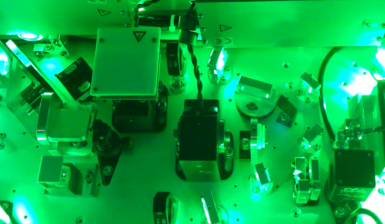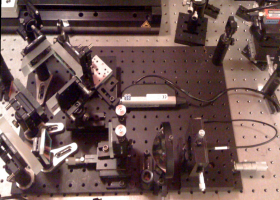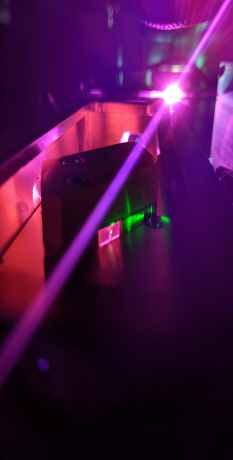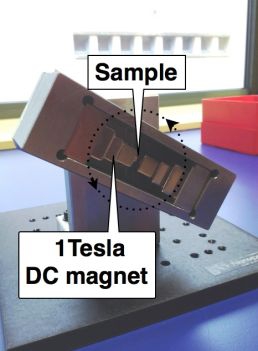
As an alternative to expensive electromagnet, we have built a spinning magnet which delivers a 1T magnetic field at the sample location. It is based on low cost DC magnets and a spinning stage.
1 Tesla DC Magnet

Sketch of the experimental configuration for photoacoustic transduction with the pulse shaper, from [13].
The Death Star pulse shaper, originally designed at Keith Nelson group @MIT, rely on a multiple recirculating reflection design as illustrated in the sketch above. A 100 femtosecond input laser pulse @790 nm makes seven round trips inside the Death Star, each slightly displaced spatially, so that seven pulses, evenly spaced in time, emerge from the partial reflector. The pulse intensities form a nearly Gaussian envelope determined by the partial reflector that have different partial reflectivities in different regions. The difference in travel time of the individual pulses was compensated by a pair of parallel mirrors whose distance exactly matches half the round trip length in the recirculating system when the delay line is set at its minimum delay. This allowed the temporal overlap of the seven transmitted pulses in time and space on the sample. The temporal interval between pulses is computer controled by movement of the delay line which linearly increases the duration of the seven-pulse sequence and provide pulse repetition rates tunable over the entire GHz to THz range.
The Death Star can be used for many different applications when train pulses of equally time delayed picosecond pulses are needed. In our case, we used it to preferentially excite a specific ultrasonic frequency in the GHz frequency range.
Pic of the compact Death Star pulse shaper.
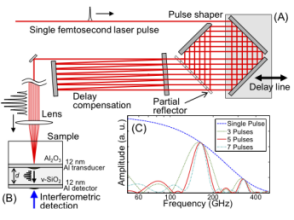
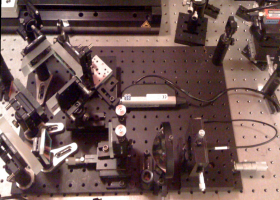

The Cavity Dumper is an acousto-optical switch placed inside the femtosecond laser resonator for intracavity operation. It reduces the pulse repetition rate of the modelocked laser system, while at the same time it increases the pulse energy by a factor of 4 approximately, which is a great benefit in comparison with standard pulse pickers placed outside the cavity that don't increase the pulse energy. The PulseSwitch reaches pulse energies of more than 40nJ (@500kHz, 800nm), a multiple of the pulse energies usually reached with CW modelocked Ti:S lasers. Pulse repetition rates can be selected between 200Hz to 9MHz. An external trigger offers the possibility of even lower repetition rates down to single shot.
The commercial APE PulseSwitch has been developed for the Coherent Mira. It works as it is in a perfect lab environment, with excellent temperature stability. It is not the case of our lab, and most probably of many labs in the world when long term laser power stability is an issue. Sometimes our measurements requires days of averaging and it is of primarily importance that the laser remains stable during acquisition. Because of this reason, we decided to fight un all the parts inside the APE PulseSwitch and to incorporate them into the MIRA cavity.
Death Star Pulse shaper

Pulse Switch Cavity Dumper from incorporated into the femtosecond MIRA cavity . All the Cavity Dumper parts are incorporated inside the MIRA box. In that way the laser cavity is much more stable to environmental noise and temperature fluctuation.
Customized MIRA Cavity Dumper

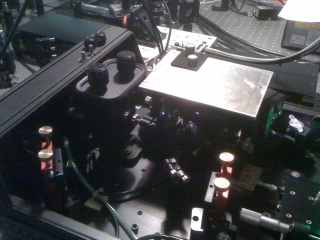
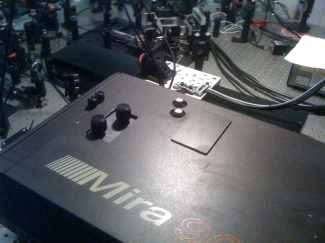
Lab Tour
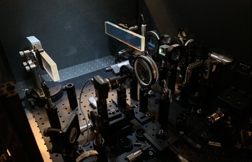
>>Menu
CNRS
Thomas Pezeril

